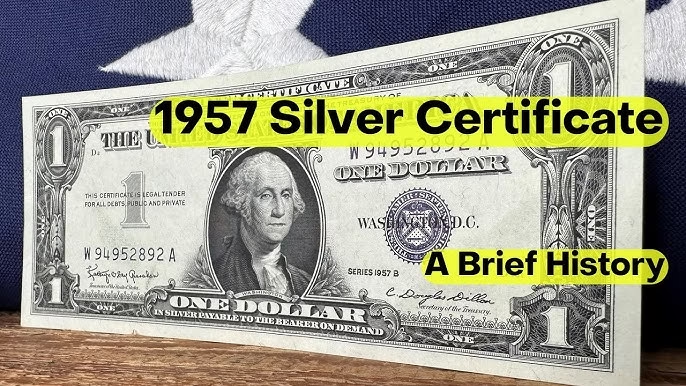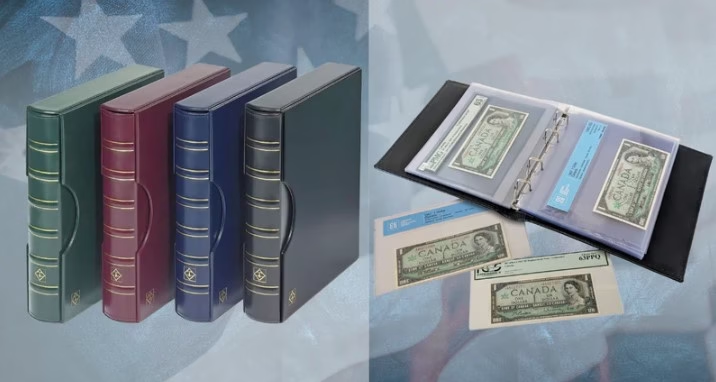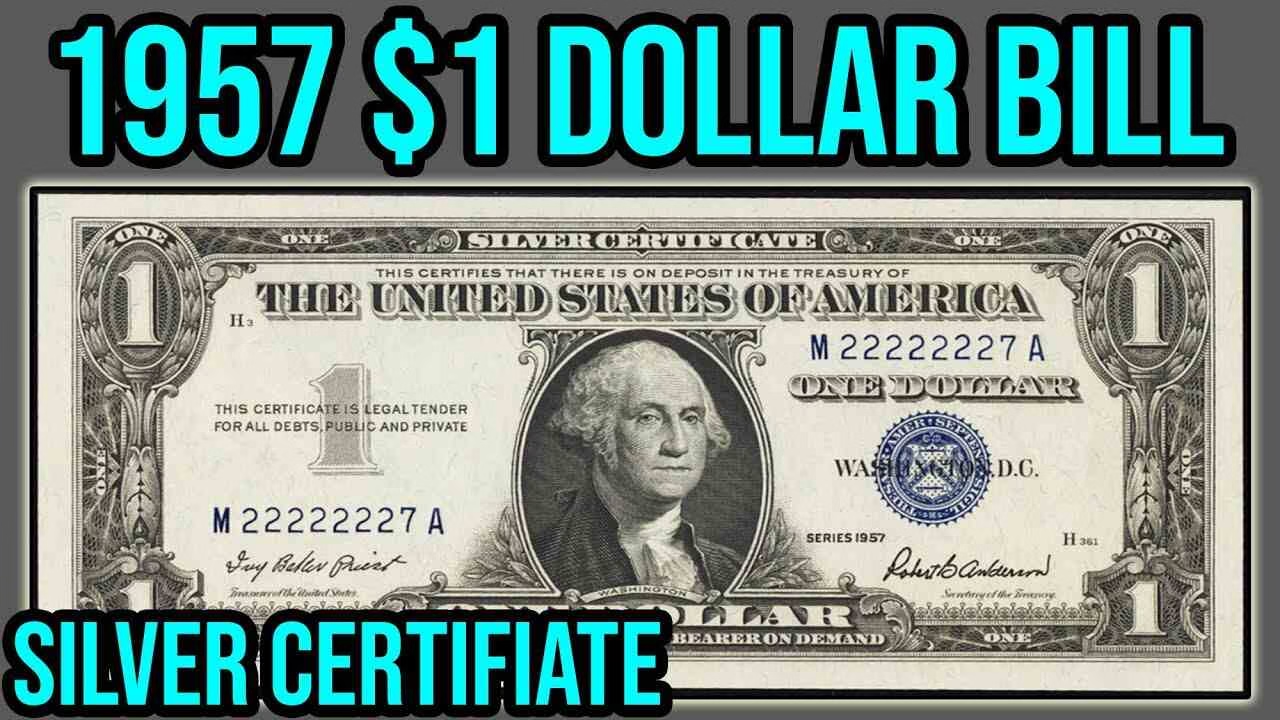1957 Silver Certificate Value Guide: What Is It Worth Today?
Introduction
The 1957 Silver Certificate is one of the most recognized pieces of U.S. paper currency among collectors and history enthusiasts. Issued during a time when paper money could still be exchanged for silver, these certificates hold both historical and collectible value.
While no longer redeemable for silver, they continue to attract attention due to their classic design, historical background, and potential worth in today’s collector markets. Whether you’ve inherited one, found it in a drawer, or are considering buying or selling, understanding its background and value is essential. This guide will walk you through the key facts, types, and factors that influence the current market value of a 1957 Silver Certificate.
History of the 1957 Silver Certificate

The 1957 Silver Certificate was part of the last series of U.S. paper currency backed by actual silver. These notes were issued from 1957 through the early 1960s, just before the U.S. discontinued the silver redemption policy. The series includes 1957, 1957A, and 1957B notes, all bearing similar designs but with different signatures and production dates. They were primarily used in everyday transactions, but once silver redemption ended in 1968, their practical use ceased—making them a collectible item with a nostalgic link to the nation’s monetary past.
Design and Features
The 1957 Silver Certificate features a portrait of George Washington on the front and the words “Silver Certificate” clearly printed above. The back showcases the familiar “ONE DOLLAR” layout in green ink, similar to today’s $1 bills. A distinctive blue seal and serial numbers help distinguish it from Federal Reserve Notes. Variations in signatures and subtle design details can help identify specific series and potential collector value. Its clean and classic look has made it a favorite among beginners and seasoned currency collectors alike.
Types and Series: 1957, 1957A, and 1957B
There are three variations of the 1957 Silver Certificate: 1957, 1957A, and 1957B. While the design remains largely the same across all three, each series includes different combinations of signatures from the Treasurer of the United States and the Secretary of the Treasury. These subtle differences can affect the note’s collectible value. Collectors often seek out all three versions to complete a set. While common in circulated condition, uncirculated notes and rare signature combinations are more desirable and can fetch higher prices.
How to Identify a Star Note
A “Star Note” is a special type of replacement note used by the U.S. Bureau of Engraving and Printing when a note is damaged during production. Instead of reusing the same serial number, a star symbol (*) is added at the beginning or end of the serial. These notes are printed in smaller quantities, making them rarer and often more valuable. Collectors highly prize 1957 Star Notes—especially in pristine condition—due to their scarcity and distinctiveness among regular issues.
Factors That Affect Value

Several key factors determine the market value of a 1957 Silver Certificate. The most important is condition—uncirculated notes with no folds, stains, or wear are worth more. Serial numbers also matter: low numbers, repeating digits, or patterns can increase value. Star Notes and notes with printing errors are often more collectible. Finally, demand in the collectors’ market can influence prices. Understanding these factors helps you accurately assess the worth of your certificate, whether you’re buying, selling, or simply preserving it.
Current Market Value
The value of a 1957 Silver Certificate varies based on condition, series, and rarity. In circulated condition, most notes are worth around $2 to $5. Uncirculated examples can range from $10 to $20 or more. Star Notes and those with unique serial numbers or errors may fetch significantly higher prices, sometimes exceeding $50. While these certificates are not rare, the collector demand keeps their value above face value. Always check current market trends or consult a currency expert for accurate appraisals.
Where to Buy or Sell
You can buy or sell 1957 Silver Certificates through various channels, including coin shops, currency dealers, online marketplaces like eBay, and collector forums. Local coin shows and auctions also offer opportunities for in-person transactions. When selling, having your note graded or appraised can boost buyer confidence and price. Buyers should be cautious of fakes or overpriced listings, especially online. Always research the seller’s reputation and compare similar sales to ensure a fair and honest transaction.
Common Myths and Misconceptions
Many believe all 1957 Silver Certificates are extremely rare and highly valuable, but most are quite common in circulated condition. Another misconception is that they can still be redeemed for silver—this is no longer true since 1968. Some also assume any note with a star or old appearance is automatically worth hundreds of dollars. In reality, only specific factors—like condition, rarity, and unique features—significantly increase value. Knowing the facts helps avoid disappointment and ensures realistic expectations when buying or selling.
How to Preserve Your Silver Certificate

Proper care is essential to maintain the value of your 1957 Silver Certificate. Always handle it with clean hands or use cotton gloves to avoid oils and dirt. Store it in a protective currency sleeve made of acid-free materials, away from direct sunlight, heat, and moisture. Avoid folding or bending the note, as creases reduce its value. If you plan to display it, use UV-protected frames. Preserving its condition not only protects its beauty but also helps retain or increase its market value.
Conclusion
The 1957 Silver Certificate holds historical charm and collectible interest, even if it no longer carries silver redemption value. Its worth today depends on various factors, including condition, rarity, and special features like star notes or serial numbers. Whether you’re a seasoned collector or someone who stumbled upon one, understanding its background and market value is the first step to making informed decisions. Treat your certificate with care, and you may find it’s more than just an old dollar—it’s a piece of American currency history.
You Can Also Read: How Big is Israel Compared to the United States?
FAQS
Are 1957 silver certificates worth anything?
Silver certificate dollar bills can range in value from $1.50 to tens of thousands of dollars. Their worth depends on rarity, serial number, condition, and specialty attributes. Common 1935 and 1957 series notes are usually valued slightly above face value.
Can I still spend a 1957 silver certificate?
Such notes used to be legal tender in the United States but are now obsolete.
How do I identify a 1957 silver certificate?
1957 $1 Silver Certificate, Star Note CUNC
- From the first $1 series with the motto IN GOD WE TRUST.
- Less than 11% of 1957 $1 Silver Certificates have stars.
- Blue seal and serial numbers.
- Priest-Anderson signatures.
How much is a 1957 Star Note worth?
Star notes from the series of 1957 are very very common. In average condition they sell for about $3 each.
Which silver certificate is worth money?
Rare and Valuable Silver Certificates
1896 $1 Silver Certificate Educational Series: Featuring an elaborate design and portraits of George and Martha Washington, this rare bill has sold for as much as $10,000. 1886 $5 Silver Certificate (Ulysses S. Grant): This certificate, featuring a portrait of Ulysses S.
